Zhengyang Mao
Towards Graph Contrastive Learning: A Survey and Beyond
May 20, 2024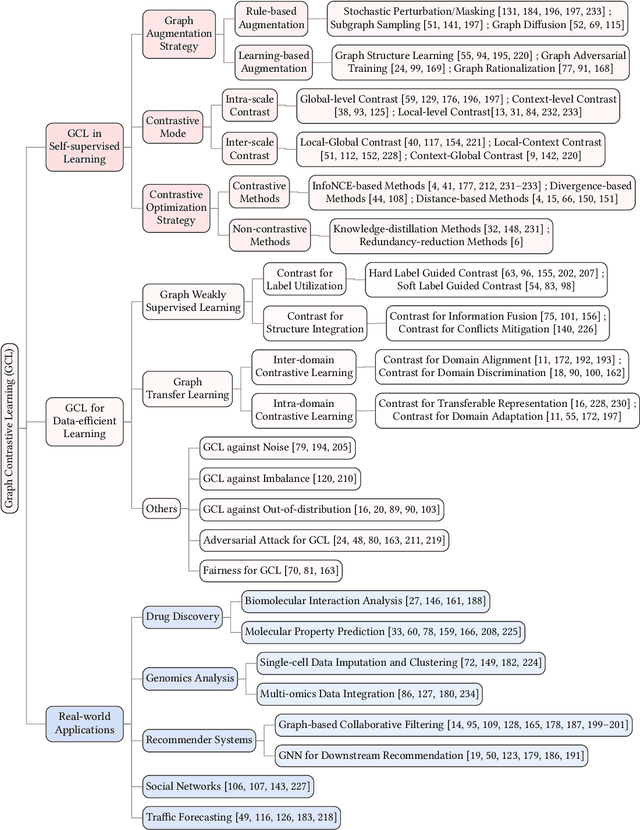
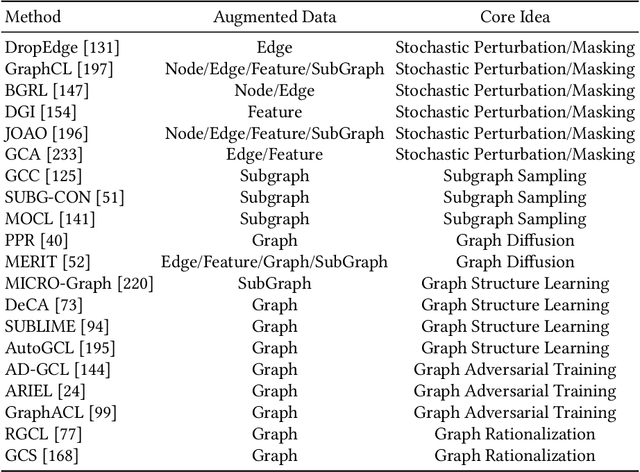
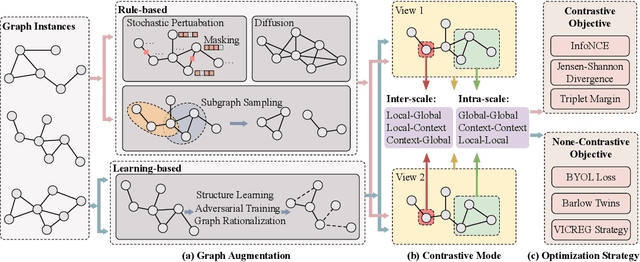
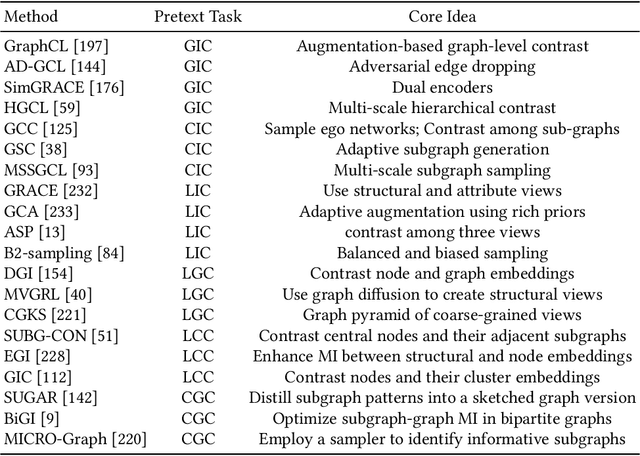
Abstract:In recent years, deep learning on graphs has achieved remarkable success in various domains. However, the reliance on annotated graph data remains a significant bottleneck due to its prohibitive cost and time-intensive nature. To address this challenge, self-supervised learning (SSL) on graphs has gained increasing attention and has made significant progress. SSL enables machine learning models to produce informative representations from unlabeled graph data, reducing the reliance on expensive labeled data. While SSL on graphs has witnessed widespread adoption, one critical component, Graph Contrastive Learning (GCL), has not been thoroughly investigated in the existing literature. Thus, this survey aims to fill this gap by offering a dedicated survey on GCL. We provide a comprehensive overview of the fundamental principles of GCL, including data augmentation strategies, contrastive modes, and contrastive optimization objectives. Furthermore, we explore the extensions of GCL to other aspects of data-efficient graph learning, such as weakly supervised learning, transfer learning, and related scenarios. We also discuss practical applications spanning domains such as drug discovery, genomics analysis, recommender systems, and finally outline the challenges and potential future directions in this field.
Hypergraph-enhanced Dual Semi-supervised Graph Classification
May 08, 2024

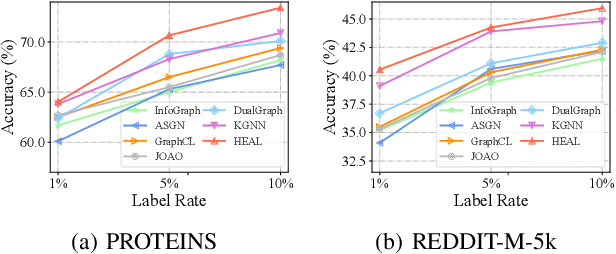
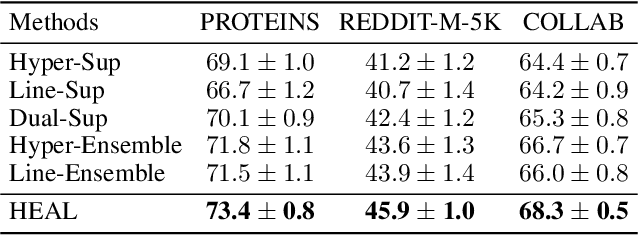
Abstract:In this paper, we study semi-supervised graph classification, which aims at accurately predicting the categories of graphs in scenarios with limited labeled graphs and abundant unlabeled graphs. Despite the promising capability of graph neural networks (GNNs), they typically require a large number of costly labeled graphs, while a wealth of unlabeled graphs fail to be effectively utilized. Moreover, GNNs are inherently limited to encoding local neighborhood information using message-passing mechanisms, thus lacking the ability to model higher-order dependencies among nodes. To tackle these challenges, we propose a Hypergraph-Enhanced DuAL framework named HEAL for semi-supervised graph classification, which captures graph semantics from the perspective of the hypergraph and the line graph, respectively. Specifically, to better explore the higher-order relationships among nodes, we design a hypergraph structure learning to adaptively learn complex node dependencies beyond pairwise relations. Meanwhile, based on the learned hypergraph, we introduce a line graph to capture the interaction between hyperedges, thereby better mining the underlying semantic structures. Finally, we develop a relational consistency learning to facilitate knowledge transfer between the two branches and provide better mutual guidance. Extensive experiments on real-world graph datasets verify the effectiveness of the proposed method against existing state-of-the-art methods.
A Survey of Graph Neural Networks in Real world: Imbalance, Noise, Privacy and OOD Challenges
Mar 07, 2024Abstract:Graph-structured data exhibits universality and widespread applicability across diverse domains, such as social network analysis, biochemistry, financial fraud detection, and network security. Significant strides have been made in leveraging Graph Neural Networks (GNNs) to achieve remarkable success in these areas. However, in real-world scenarios, the training environment for models is often far from ideal, leading to substantial performance degradation of GNN models due to various unfavorable factors, including imbalance in data distribution, the presence of noise in erroneous data, privacy protection of sensitive information, and generalization capability for out-of-distribution (OOD) scenarios. To tackle these issues, substantial efforts have been devoted to improving the performance of GNN models in practical real-world scenarios, as well as enhancing their reliability and robustness. In this paper, we present a comprehensive survey that systematically reviews existing GNN models, focusing on solutions to the four mentioned real-world challenges including imbalance, noise, privacy, and OOD in practical scenarios that many existing reviews have not considered. Specifically, we first highlight the four key challenges faced by existing GNNs, paving the way for our exploration of real-world GNN models. Subsequently, we provide detailed discussions on these four aspects, dissecting how these solutions contribute to enhancing the reliability and robustness of GNN models. Last but not least, we outline promising directions and offer future perspectives in the field.
GPS: Graph Contrastive Learning via Multi-scale Augmented Views from Adversarial Pooling
Jan 29, 2024Abstract:Self-supervised graph representation learning has recently shown considerable promise in a range of fields, including bioinformatics and social networks. A large number of graph contrastive learning approaches have shown promising performance for representation learning on graphs, which train models by maximizing agreement between original graphs and their augmented views (i.e., positive views). Unfortunately, these methods usually involve pre-defined augmentation strategies based on the knowledge of human experts. Moreover, these strategies may fail to generate challenging positive views to provide sufficient supervision signals. In this paper, we present a novel approach named Graph Pooling ContraSt (GPS) to address these issues. Motivated by the fact that graph pooling can adaptively coarsen the graph with the removal of redundancy, we rethink graph pooling and leverage it to automatically generate multi-scale positive views with varying emphasis on providing challenging positives and preserving semantics, i.e., strongly-augmented view and weakly-augmented view. Then, we incorporate both views into a joint contrastive learning framework with similarity learning and consistency learning, where our pooling module is adversarially trained with respect to the encoder for adversarial robustness. Experiments on twelve datasets on both graph classification and transfer learning tasks verify the superiority of the proposed method over its counterparts.
A Survey on Graph Neural Networks in Intelligent Transportation Systems
Jan 02, 2024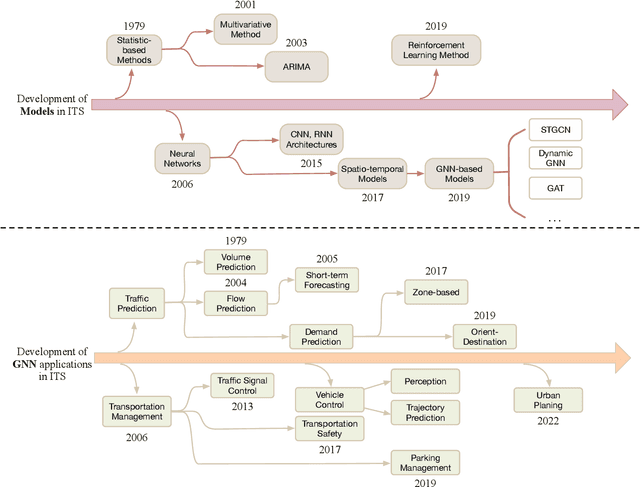
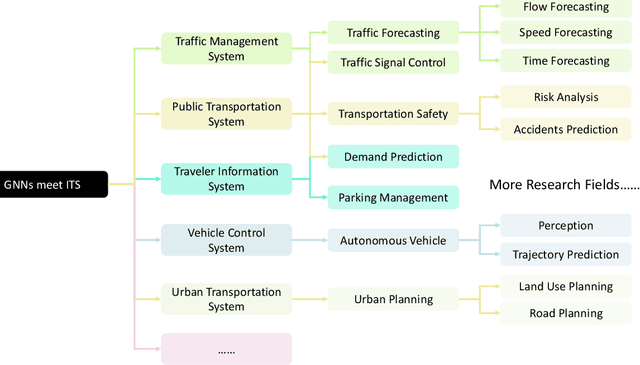


Abstract:Intelligent Transportation System (ITS) is vital in improving traffic congestion, reducing traffic accidents, optimizing urban planning, etc. However, due to the complexity of the traffic network, traditional machine learning and statistical methods are relegated to the background. With the advent of the artificial intelligence era, many deep learning frameworks have made remarkable progress in various fields and are now considered effective methods in many areas. As a deep learning method, Graph Neural Networks (GNNs) have emerged as a highly competitive method in the ITS field since 2019 due to their strong ability to model graph-related problems. As a result, more and more scholars pay attention to the applications of GNNs in transportation domains, which have shown excellent performance. However, most of the research in this area is still concentrated on traffic forecasting, while other ITS domains, such as autonomous vehicles and urban planning, still require more attention. This paper aims to review the applications of GNNs in six representative and emerging ITS domains: traffic forecasting, autonomous vehicles, traffic signal control, transportation safety, demand prediction, and parking management. We have reviewed extensive graph-related studies from 2018 to 2023, summarized their methods, features, and contributions, and presented them in informative tables or lists. Finally, we have identified the challenges of applying GNNs to ITS and suggested potential future directions.
ALEX: Towards Effective Graph Transfer Learning with Noisy Labels
Sep 26, 2023Abstract:Graph Neural Networks (GNNs) have garnered considerable interest due to their exceptional performance in a wide range of graph machine learning tasks. Nevertheless, the majority of GNN-based approaches have been examined using well-annotated benchmark datasets, leading to suboptimal performance in real-world graph learning scenarios. To bridge this gap, the present paper investigates the problem of graph transfer learning in the presence of label noise, which transfers knowledge from a noisy source graph to an unlabeled target graph. We introduce a novel technique termed Balance Alignment and Information-aware Examination (ALEX) to address this challenge. ALEX first employs singular value decomposition to generate different views with crucial structural semantics, which help provide robust node representations using graph contrastive learning. To mitigate both label shift and domain shift, we estimate a prior distribution to build subgraphs with balanced label distributions. Building on this foundation, an adversarial domain discriminator is incorporated for the implicit domain alignment of complex multi-modal distributions. Furthermore, we project node representations into a different space, optimizing the mutual information between the projected features and labels. Subsequently, the inconsistency of similarity structures is evaluated to identify noisy samples with potential overfitting. Comprehensive experiments on various benchmark datasets substantiate the outstanding superiority of the proposed ALEX in different settings.
Towards Long-Tailed Recognition for Graph Classification via Collaborative Experts
Sep 05, 2023Abstract:Graph classification, aiming at learning the graph-level representations for effective class assignments, has received outstanding achievements, which heavily relies on high-quality datasets that have balanced class distribution. In fact, most real-world graph data naturally presents a long-tailed form, where the head classes occupy much more samples than the tail classes, it thus is essential to study the graph-level classification over long-tailed data while still remaining largely unexplored. However, most existing long-tailed learning methods in visions fail to jointly optimize the representation learning and classifier training, as well as neglect the mining of the hard-to-classify classes. Directly applying existing methods to graphs may lead to sub-optimal performance, since the model trained on graphs would be more sensitive to the long-tailed distribution due to the complex topological characteristics. Hence, in this paper, we propose a novel long-tailed graph-level classification framework via Collaborative Multi-expert Learning (CoMe) to tackle the problem. To equilibrate the contributions of head and tail classes, we first develop balanced contrastive learning from the view of representation learning, and then design an individual-expert classifier training based on hard class mining. In addition, we execute gated fusion and disentangled knowledge distillation among the multiple experts to promote the collaboration in a multi-expert framework. Comprehensive experiments are performed on seven widely-used benchmark datasets to demonstrate the superiority of our method CoMe over state-of-the-art baselines.
RAHNet: Retrieval Augmented Hybrid Network for Long-tailed Graph Classification
Aug 04, 2023Abstract:Graph classification is a crucial task in many real-world multimedia applications, where graphs can represent various multimedia data types such as images, videos, and social networks. Previous efforts have applied graph neural networks (GNNs) in balanced situations where the class distribution is balanced. However, real-world data typically exhibit long-tailed class distributions, resulting in a bias towards the head classes when using GNNs and limited generalization ability over the tail classes. Recent approaches mainly focus on re-balancing different classes during model training, which fails to explicitly introduce new knowledge and sacrifices the performance of the head classes. To address these drawbacks, we propose a novel framework called Retrieval Augmented Hybrid Network (RAHNet) to jointly learn a robust feature extractor and an unbiased classifier in a decoupled manner. In the feature extractor training stage, we develop a graph retrieval module to search for relevant graphs that directly enrich the intra-class diversity for the tail classes. Moreover, we innovatively optimize a category-centered supervised contrastive loss to obtain discriminative representations, which is more suitable for long-tailed scenarios. In the classifier fine-tuning stage, we balance the classifier weights with two weight regularization techniques, i.e., Max-norm and weight decay. Experiments on various popular benchmarks verify the superiority of the proposed method against state-of-the-art approaches.
 Add to Chrome
Add to Chrome Add to Firefox
Add to Firefox Add to Edge
Add to Edge